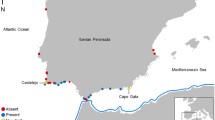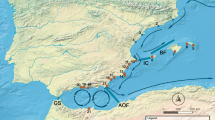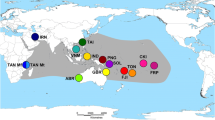Abstract
Understanding patterns of gene flow, selection and genetic diversity within and among populations is a critical element of predicting how long-term changes in environmental conditions are likely to affect species distribution. The intertidal mussel Perna perna consists of two distinct genetic lineages in South Africa, but the mechanisms maintaining these lineages remains obscure. We used regional oceanography and lineage-specific responses to environmental conditions as proxies for gene flow and local selection, respectively, to test how these mechanisms could shape population genetic structure. Laboratory experiments supported the field findings that mussels on the east coast (eastern lineage) are physiologically more tolerant of sand inundation and high temperatures than those on the south coast (western lineage). Temperature loggers mimicking mussel body temperatures revealed that mussels experience higher body temperatures during aerial exposure on the subtropical east coast than on the temperate south coast. Translocations showed that, on the east coast, the western lineage suffered higher mortality rates than local individuals, while on the south coast, mortality rates did not differ significantly between the lineages. Nearshore drogues showed remarkably little overlap between the trajectories of drifters released off the south coast and those released off the east coast. Physiological tolerances can thus explain the exclusion of western individuals from the east coast, but they cannot explain the exclusion of the eastern lineage from the south coast. In contrast, however, ocean dynamics may limit larval dispersal between the two lineages, helping to explain the absence of eastern individuals from the south coast. We emphasise the importance of a multidisciplinary approach in a macro-ecological context to understand fully the mechanisms promoting evolutionary divergence between genetic entities. Our results suggest that phylogeographic patterns of Perna perna may be maintained by a combination of local conditions and the isolating effect of the Agulhas Current that reduces gene exchange.





Similar content being viewed by others
References
Abelson A, Denny M (1997) Settlement of marine organisms in flow. Annu Rev Ecol Syst 28:317–339
Airoldi L (1998) Roles of disturbance, sediment stress, and substratum retention on spatial dominance in algal turf. Ecology 79:2759–2770
Airoldi L (2003) The effects of sedimentation on rocky coast assemblages. Oceanogr Mar Biol Annu Rev 41:161–236
Avise JC (2000) Phylogeography. Harvard University Press, Cambridge
Balch T, Scheibling RE (2000) Temporal and spatial variability in settlement and recruitment of echinoderms in kelp beds and barrens off Nova Scotia. Mar Ecol Prog Ser 205:139–154
Bally R, McQuaid CD, Brown AC (1984) Shores of mixed sand and rock: an unexplored marine ecosystem. S Afr J Sci 80:500–503
Bayne BL, Bayne CJ, Carefoot TJ, Thompson RJ (1976) The physiological ecology of Mytilus californianus Conrad. Oecologia 22:211–228
Braby C, Somero GN (2006) Following the heart: temperature and salinity effects on heart rate in native and invasive species of blue mussels (genus Mytilus). J Exp Biol 209:2554–2566
Braid BA, Moore JD, Robbins TT, Hedrick RP, Tjeerdema RS, Friedman CS (2005) Health and survival of red abalone, Haliotis rufescens, under varying temperature, food supply, and exposure to the agent of withering syndrome. J Invertebr Pathol 89:219–231
Bustamante RH, Branch GM, Eekhout S, Robertson B, Zoutendyk P, Schleyer M, Dye A, Hanekom N, Keats D, Jurd M, McQuaid CD (1995) Gradients of intertidal primary productivity around the coast of South Africa and their relationships with consumer biomass. Oecologia 102:189–201
Cheung SG, Shin PKS (2005) Size effects of suspended particles on gill damage in green-lipped mussel Perna viridis. Mar Pollut Bull 51:110–801
Chiswell SM, Wilkin J, Booth JD, Stanton B (2003) Trans-Tasman sea-larval transport: is Australia a source for New Zealand rock lobsters? Mar Ecol Prog Ser 247:173–182
Chown SL, Gaston KJ (2008) Macrophysiology for a changing world. Proc R Soc B 275:1469–1478
Clarke A (1993) Temperature and extinction in the sea: a physiologist’s view. Paleobiology 19:499–518
Edkins MT, Teske PR, Griffiths CL, Papadopulos I (2007) Genetic and morphological analyses suggest that southern African crown crabs, Hymenosoma orbiculare, represent five distinct species. Crustaceana 80:667–683
Elvin DW, Gonor JJ (1979) The thermal regime of an intertidal Mytilus californianus Conrad population on the central Oregon coast. J Exp Mar Biol Ecol 39:265–279
Emanuel BP, Bustamante RH, Branch GM, Eekhout S, Odendaal FJ (1992) A zoogeographic and functional approach to the selection of marine reserves on the west coast of South Africa. S Afr J Mar Sci 12:341–354
Fitzhenry T, Halpin PM, Helmuth B (2004) Testing the effects of wave exposure, site, and behaviour on intertidal mussel body temperatures: applications and limits of temperature logger design. Mar Biol 145:339–349
Galarza JA, Carreras-Carbonell J, Macpherson E, Pascual M, Roques S, Turner GF, Rico C (2009) The influence of oceanographic fronts and early-life-history traits on connectivity among littoral fish species. PNAS 106:1473–1478
Gallager SM, Manuel JL, Manning DA, O’Dor R (1996) The vertical distribution of scallop larvae Placopecten magellanicus in 9 m deep mesocosms as a function of light, food and temperature. Part I. Ontogeny of vertical migration behaviour. Mar Biol 124:679–692
Gaylord B, Gaines SD (2000) Temperature or transport? Range limits in marine species mediated solely by flow. Am Nat 155:769–789
Gompert Z, Forister ML, Fordyce DA, Nice CC (2008) Widespread mito-nuclear discordance with evidence for introgressive hybridization and selective sweeps in Lycaeides. Mol Ecol 17:5231–5244
Goschen WS, Schumann EH (1988) Ocean current and temperature structures in Algoa Bay and beyond in November 1986. S Afr J Mar Sci 7:101–116
Goschen WS, Schumann EH (1990) Agulhas current variability and inshore structures off the Cape Province, South Africa. J Geophys Res 95:667–678
Halpin PM, Sorte CJ, Hofmann GE, Menge BA (2002) Patterns of variation in levels of Hsp70 in natural rocky shore populations from microscales to mesoscales. Integr Comp Biol 42:815–824
Harley CDG (2008) Tidal dynamics, topographic orientation, and temperature-mediated mass mortalities on rocky shores. Mar Ecol Prog Ser 371:37–46
Harley CDG, Helmuth BST (2003) Local and regional scale effects of wave exposure, thermal stress, and absolute vs. effective shore level on patterns of intertidal zonation. Limnol Oceanogr 48:1498–1508
Harrison TD (2000) Preliminary assessment of the biogeography of the fishes in South African estuaries. Mar Freshw Res 53:479–490
Hayden BP, Dolan R (1976) Coastal marine fauna and marine climates of the Americas. J Biogeogr 3:71–81
Hedgpeth JW (1957) Estuaries and lagoons. II. Biological aspects. In: Hedgpeth JW (ed) Treatise on marine ecology and paleoecology 1. Memoir No. 67. Geological Society of America, Boulder, pp 673–693
Helmuth B (1998) Intertidal mussel microclimates: predicting the body temperature of a sessile invertebrate. Ecol Monogr 68:29–52
Helmuth B, Hofmann GE (2001) Microhabitats, thermal heterogeneity, and patterns of physiological stress in the rocky intertidal zone. Biol Bull 201:374–384
Helmuth B, Harley CDG, Halpin P, O’Donnell M, Hofmann GE, Blanchette C (2002) Climate change and latitudinal patterns of intertidal thermal stress. Science 298:1015–1017
Hilbish TJ, Mullinax A, Dolven SI, Meyer A, Koehn RK, Rawson PD (2000) Origin of the antitropical distribution pattern in marine mussels (Mytilus spp.): routes and timing of transequatorial migration. Mar Biol 136:69–77
Hofmann GE, Somero GN (1995) Evidence for protein damage at environmental temperatures: seasonal changes in levels of ubiquitin conjugates and hsp70 in the intertidal mussel Mytilus trossulus. J Exp Biol 198:1509–1518
Kinlan BP, Gaines SD (2003) Propagule dispersal in marine and terrestrial environments: a community perspective. Ecology 84:2007–2020
Lent CM (1969) Adaptations of the ribbed mussel, Modiolus demissus (Dillvvyn), to the intertidal habitat. Am Zool 9:283–292
Littler MM, Martz DR, Littler DS (1983) Effects of recurrent sand deposition on rocky intertidal organisms: importance of substrate heterogeneity in a fluctuating communities. Mar Ecol Prog Ser11:129–139
Lutjeharms JRE (1998) Coastal hydrography. In: Lubke R, de Moor I (eds) Eastern and southern Cape coasts. University of Cape Town Press/Grahamstown Branch of the Wildlife and Environment Society of Southern Africa, Ronde-bosch, pp 50–61
Lutjeharms JRE (2004) The coastal oceans of south-eastern Africa. Sea 14:781–832
Manuel JL, O’Dor RK (1997) Vertical migration for horizontal transport while avoiding predators: I. A tidal/diel model. J Plankton Res 19:1929–1947
Marshall DJ, McQuaid CD (1989) The influence of the respiratory response on the tolerance to sand inundation of the limpets Patella granularis (L) (Prosobranchia) and Siphonaria capensis (Q et G) (Pulmonata). J Exp Mar Biol Ecol 129:191–201
McDonald JH, Seed R, Koehn RK (1991) Allozymes and morphometric characters of three species of Mytilus in the Northern and Southern Hemispheres. Mar Biol 3:323–333
McQuaid CD, Dower KM (1990) Enhancement of habitat heterogeneity and species richness on rocky shores inundated by sand. Oecologia 84:142–144
McQuaid CD, Phillips TE (2000) Limited wind-driven dispersal of intertidal mussel larvae: in situ evidence from the plankton and the spread of the invasive species Mytilus galloprovincialis in South Africa. Mar Ecol Prog Ser 201:211–220
Menge BA, Olson AM, Dahlhoff E (2002) Environmental stress, bottom-up effects, and community dynamics: integrating molecular-physiological with ecological approaches. Integr Comp Biol 42:892–908
Michalek-Wagner K, Willis BL (2001) Impacts of bleaching on the soft coral Lobophytum compactum. I. Fecundity, fertilisation and offspring viability. Coral Reefs 19:231–239
Minchinton TE, Scheibling RS (1991) The influence of larval supply and settlement on the population structure of barnacles. Ecology 72:1867–1879
Moon TW, Pritchard AW (1970) Metabolic adaptations in vertically-separated populations of Mytilus californianus Conrad. J Exp Mar Biol Ecol 5:79–90
Newell RC (1979) Biology of intertidal animals, 3rd edn. Marine Ecological Surveys, Faversham
Nicastro KR, Zardi GI, McQuaid CD, Stephens L, Radloff S, Blatch GL (2010) The role of gaping behaviour in habitat partitioning between coexisting intertidal mussels. BMC Ecol 10:17
Niiler PP, Sybrandy AS Bi K, Poulain PM, Bitterman D (1995) Measurement of the water-following capability of holey-sock and TRISTAR drifters. Deep Sea Res I 42:1951–1964
O’Hara TD, Poore GCB (2000) Patterns of distribution for southern Australian marine echinoderms and decapods. J Biogeogr 27:1321–1335
Palumbi SR (1994) Genetic divergence, reproductive isolation, and marine speciation. Annu Rev Ecol Syst 25:547–572
Petes LE, Harvell CD, Peters EC, Webb MAH, Mullen KM (2003) Pathogens compromise reproduction and induce melanization in Caribbean seafans. Mar Ecol Prog Ser 264:167–171
Petes LE, Menge BA, Murphy GD (2007) Environmental stress decreases survival, growth, and reproduction in New Zealand mussels. J Exp Mar Biol Ecol 351:83–91
Philippart CJM, van Aken HM, Beukema JJ, Bos OG, Cadée GC, Dekker R (2003) Climate-related changes in recruitment of the bivalve Macoma balthica. Limnol Oceanogr 48:2171–2185
Pincebourde S, Sanford E, Helmuth B (2008) Body temperature during low tide alters the feeding performance of a top intertidal predator. Limnol Oceanogr 53:1562–1573
Pineda J (2000) Linking larval settlement to larval transport: assumptions, potentials, and pitfalls. Oceanogr East Pac 1:84–105
Place SP, O’Donnell MJ, Hofmann GE (2008) Gene expression in the intertidal mussel Mytilus californianus: physiological response to environmental factors on a biogeographic scale. Mar Ecol Prog Ser 356:1–14
Prada C, Schizas NV, Yoshioka PM (2008) Phenotypic plasticity or speciation? A case from clonal marine organisms. BMC Evol Biol 8:47
Pringle JM, Wares JP (2007) The maintenance of alongshore variation in allele frequency in a coastal ocean. Mar Ecol Prog Ser 335:69–84
Ridgeway TM, Stewart BA, Branch GM, Hodgson AN (1998) Morphological and genetic differentiation of Patella granularis (Gastropoda: Patellidae): recognition of two sibling species along the coast of southern Africa. J Zool 245:317–333
Roberts CM (1997) Connectivity and management of Caribbean coral reefs. Science 278:1454–1457
Robinson TB, Griffiths CL, McQuaid CD, Rius M (2005) Marine alien species of South Africa—status and impacts. Afr J Mar Sci 27:297–306
Schneider KR (2008) Heat stress in the intertidal: comparing survival and growth of an invasive and native mussel under a variety of thermal conditions. Biol Bull 215:253–264
Schneider KR, Van Thiel LE, Helmuth B (2010) Interactive effects of food availability and aerial body temperature on the survival of two intertidal Mytilus species. J Therm Biol 35:161–166
Shanks AL, Brink L (2005) Upwelling, downwelling, and cross-shelf transport of bivalve larvae: test of a hypothesis. Mar Ecol Prog Ser 302:1–12
Shanks AL, Grantham BA, Carr MH (2003) Propagule dispersal distance and the size and spacing of marine reserves. Ecol Appl 13:S159–S169
Sotka EE, Palumbi SR (2006) The use of genetic clines to estimate dispersal distances of marine larvae. Ecology 87:1094–1103
Sotka EE, Wares JP, Barth JA, Crossberg RK, Palumbi SR (2004) Strong genetic clines and geographical variation in gene flow in the rocky intertidal barnacle Balanus glandula. Mol Ecol 13:2143–2156
Sponaugle S, Cowen RK, Shanks A, Morgan SG, Leis JM, Pineda J, Boehlert GW, Kingsford MJ, Lindeman K, Grimes C, Munro JL (2002) Predicting self-recruitment in marine populations: biophysical correlates and mechanisms. Bull Mar Sci 70:341–375
Suchanek TH (1978) The ecology of Mytilus edulis L. in exposed rocky intertidal communities. J Exp Mar Biol Ecol 31:105–120
Suchanek TH, Geller JB, Kreiser BR, Mitton JB (1997) Zoogeographic distributions of the sibling species Mytilus galloprovincialis and M. trossulus (Bivalvia: Mytilidae) and their hybrids in the North Pacific. Biol Bull 193:187–194
Tapia FJ, Pineda J (2007) Stage-specific distribution of barnacle larvae in nearshore waters: potential for limited dispersal and high mortality rates. Mar Ecol Prog Ser 342:177–190
Teske PR, McQuaid CD, Froneman PW, Barker NP (2006) Impacts of marine biogeographic boundaries on phylogeographic patterns of three South African estuarine crustaceans. Mar Ecol Prog Ser 314:283–293
Teske PR, McQuaid CD, Froneman PW, Barker NP (2007a) Impacts of marine biogeographic boundaries on phylogeographic patterns of three South African estuarine crustaceans. Mar Ecol Prog Ser 314:283–293
Teske PR, Papadopulos I, Zardi GI, McQuaid CD, Griffiths CL, Edkins MT, Barker NP (2007b) Implications of life history for genetic structure and migration rates of five southern African coastal invertebrates: planktonic, abbreviated and direct development. Mar Biol 152:697–711
Teske PR, Papadopoulos I, Newman BK, Dworschak PC, McQuaid CD, Barker NP (2008) Oceanic dispersal barriers, adaptation and larval retention: an interdisciplinary assessment of potential factors maintaining a phylogeographic break between sister lineages of an African prawn. BMC Evol Biol 8:341
Teske PR, Winker H, McQuaid CD, Barker NP (2009) A tropical/subtropical biogeographic disjunction in southeastern Africa separates two evolutionarily significant units of an estuarine prawn. Mar Biol 156:1265–1275
Tsuchiya M (1983) Mass mortality in a population of the mussel Mytilus edulis L. Caused by high temperature on rocky shores. J Exp Mar Biol Ecol 66:101–111
Van Erkom Schuring C, Griffiths CL (1991) A comparison of reproductive cycles and reproductive output in four southern African mussel species. Mar Ecol Prog Ser 76:123–134
Walther GR, Post E, Convey P, Menzel A, Parmesan C, Beebee TJC, Fromentin J-M, Hoegh-Guldberg O, Bairlein F (2002) Ecological responses to recent climate change. Nature 416:389–395
Williams GA, Morritt D (1995) Habitat partitioning and thermal tolerance in a tropical limpet, Cellana grata. Mar Ecol Prog Ser 124:89–103
Zardi GI, Nicastro KR, Porri F, McQuaid CD (2006) Sand stress as a non-determinant of habitat segregation of indigenous (Perna perna) and invasive (Mytilus galloprovincialis) mussels in South Africa. Mar Biol 148:1031–1038
Zardi GI, McQuaid CD, Teske PR, Barker NP (2007) Unexpected genetic structure of indigenous Perna perna and invasive Mytilus galloprovincialis mussel populations in South Africa. Mar Ecol Prog Ser 337:135–144
Zardi GI, Nicastro KR, McQuaid CD, Erlandsson J (2008) Sand and wave induced mortality in invasive (Mytilus galloprovincialis) and indigenous (Perna perna) mussels. Mar Biol 153:853–858
Acknowledgments
This work is based upon research supported by the South African Research Chairs Initiative of the Department of Science and Technology and National Research Foundation with additional funding from Rhodes University and from FCT (Fundação para a Ciência ea Tecnologia; project awarded to GIZ).
Author information
Authors and Affiliations
Corresponding author
Additional information
Communicated by Tony Underwood.
G. I. Zardi and K. R. Nicastro contributed equally to the work.
Rights and permissions
About this article
Cite this article
Zardi, G.I., Nicastro, K.R., McQuaid, C.D. et al. The combination of selection and dispersal helps explain genetic structure in intertidal mussels. Oecologia 165, 947–958 (2011). https://doi.org/10.1007/s00442-010-1788-9
Received:
Accepted:
Published:
Issue Date:
DOI: https://doi.org/10.1007/s00442-010-1788-9




